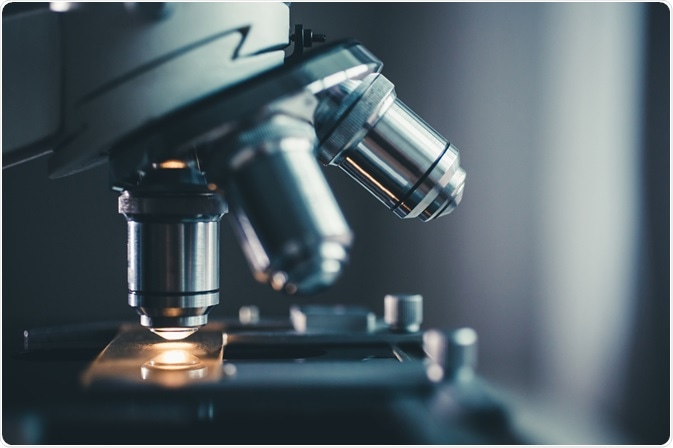Transparent microspheres can generate an image with a super-resolution of 50 nanometers. This technique provides several advantages over conventional imaging and confocal microscopy.
 Konstantin Kolosov | Shutterstock
Konstantin Kolosov | Shutterstock
Microsphere-assisted microscopy
The conventional microscopy is limited by the diffraction limit which is 250 nanometers. Thus, it is rather difficult to resolve objects that are smaller than that. However, some improvements have been made using the confocal microscopy which limits the out of focus light and solid immersion lens microscopy (SIL).
Increased numerical aperture leads to improved resolution in the SIL method where the numerical aperture is defined as n X sinƟ; n being the refractive index, and Ɵ the half angle of the objective acceptance cone.
However, the resolution of the image cannot be increased beyond a certain limit in confocal or SIL imaging methods. When using a new technique, dielectric microspheres were found to generate a resolution of up to 50 nanometers. This was possible due to their high capacity to focus the evanescent light. Also, these spheres can be placed close to the sample surface as they have a smaller contact region.
What are the advantages of microsphere-assisted microscopy?
In one study the resolution of microsphere assisted microscopy was compared to confocal and SIL microscopy. For this purpose, an array of nanocylinders 100 nanometers in diameter and with a gap of 60 nanometers were imaged using all three methods.
Nonetheless, it was not possible to resolve the structure of nanocylinders using the confocal microscopy. The sample was imaged with 405-nanometer laser with an objective lens of 0.95 numerical aperture. However, using the same objective lens, the structure could be resolved using a barium titanate glass microsphere immersed in isopropyl alcohol.
In a nutshell, the resolution of the microsphere assisted microscopy was improved due to the reduction of the wavelength of light in a medium. Also, the wavelength-scale dimensions can be modified for microspheres providing an advantage over the solid immersion lenses.
Increased magnification of microsphere assisted microscopy is also considered an advantage. The magnification of microsphere assisted microscopy has been compared to SIL and confocal imaging methods, and it was found that microsphere assisted microscopy has a superior magnification.
The relationship between magnification and refractive index of the lens was also compared in these different imaging methods. For a refractive index of 1.6, microsphere assisted microscopy could achieve a magnification of 4, while SIL could achieve a magnification of 1.5-2.
For a refractive index of 1.7, microsphere assisted microscopy could achieve a magnification of 5, while SIL could achieve a magnification of 1.5-3. This showed the higher magnification capacity of this method of microscopy.
No requirement for labeling
The method of super-resolution based on fluorescence requires the sample to be labeled with fluorescent dyes or tags. Similarly, several other microscopic methods require the need to label the sample to increase the contrast.
Often there is a debate whether such labeling of molecules can alter their behavior and properties. In case of microsphere assisted microscopy, different types of biological and non-biological samples can be directly observed in high resolution – without the need for labeling.
Are there any limitations?
Studies show that in several cases, the image generated by microsphere-assisted microscopy is associated with spherical aberration which represents the loss of image quality due to the surface geometry of the lens. However, the positive spherical aberration generated by the spherical boundary can be compensated by the negative spherical aberration due to the focal shift.
Likewise, studies have shown that the maximum contrast can be generated when the refractive index of the lens is between 1.4–1.75. Although high refractive index values are advantageous for generating super-resolution images, in case of microsphere assisted microscopy a refractive index of more than 1.8 can reduce the strength of super-resolution.
Sources
- journals.plos.org/…/journal.pone.0165194&type=printable
- https://aip.scitation.org/doi/abs/10.1063/1.4864760?journalCode=apl
- drzwang.com/onewebmedia/Nanoscience,%203,%20193-210%20(2016).pdf
Further Reading
- All Microscopy Content
- Advances in Fluorescence Microscopy
- Applications in Light Microscopy
- Electron Microscopy: An Overview
- Brief History of Microscopy
Last Updated: Mar 28, 2019

Written by
Dr. Surat P
Dr. Surat graduated with a Ph.D. in Cell Biology and Mechanobiology from the Tata Institute of Fundamental Research (Mumbai, India) in 2016. Prior to her Ph.D., Surat studied for a Bachelor of Science (B.Sc.) degree in Zoology, during which she was the recipient of anIndian Academy of SciencesSummer Fellowship to study the proteins involved in AIDs. She produces feature articles on a wide range of topics, such as medical ethics, data manipulation, pseudoscience and superstition, education, and human evolution. She is passionate about science communication and writes articles covering all areas of the life sciences.
Source: Read Full Article
